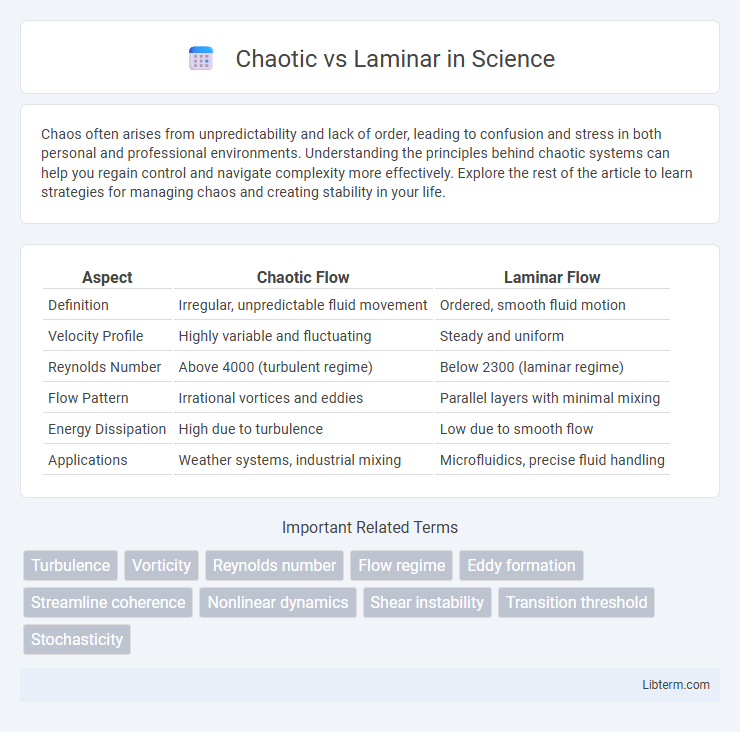Chaos often arises from unpredictability and lack of order, leading to confusion and stress in both personal and professional environments. Understanding the principles behind chaotic systems can help you regain control and navigate complexity more effectively. Explore the rest of the article to learn strategies for managing chaos and creating stability in your life.
Table of Comparison
| Aspect | Chaotic Flow | Laminar Flow |
|---|---|---|
| Definition | Irregular, unpredictable fluid movement | Ordered, smooth fluid motion |
| Velocity Profile | Highly variable and fluctuating | Steady and uniform |
| Reynolds Number | Above 4000 (turbulent regime) | Below 2300 (laminar regime) |
| Flow Pattern | Irrational vortices and eddies | Parallel layers with minimal mixing |
| Energy Dissipation | High due to turbulence | Low due to smooth flow |
| Applications | Weather systems, industrial mixing | Microfluidics, precise fluid handling |
Introduction to Chaotic and Laminar Flow
Chaotic flow, also known as turbulent flow, is characterized by irregular, unpredictable fluid motion with rapid variations in pressure and velocity, often occurring at high Reynolds numbers. Laminar flow features smooth, orderly fluid motion in parallel layers with minimal mixing and fluctuations, typically observed at low Reynolds numbers. Understanding the differences between these flow regimes is crucial for optimizing engineering applications such as pipeline design, aerodynamic performance, and heat transfer systems.
Defining Chaotic Flow
Chaotic flow, also known as turbulent flow, is characterized by irregular, unpredictable fluid movement with rapid velocity fluctuations and eddies. This contrasts with laminar flow, where fluid particles move in smooth, parallel layers with minimal mixing. Chaotic flow increases momentum, heat, and mass transfer rates due to its complex, stochastic nature.
Understanding Laminar Flow
Laminar flow refers to a smooth, orderly fluid motion characterized by parallel layers of fluid that move without disruption between them, typically occurring at low Reynolds numbers below 2,300. This flow regime minimizes friction and turbulence, resulting in predictable velocity profiles essential for applications in aerodynamics, blood flow analysis, and chemical processing. Understanding laminar flow enables engineers to design systems with reduced energy loss and improved efficiency by maintaining stable, non-turbulent fluid behavior.
Key Differences Between Chaotic and Laminar Flow
Chaotic flow, also known as turbulent flow, features irregular, unpredictable fluid motion with high velocity fluctuations and eddies, whereas laminar flow is smooth and orderly with parallel fluid layers moving at constant velocity. Key differences include Reynolds number thresholds, with laminar flow occurring at low Reynolds numbers (typically below 2000) and chaotic flow dominating at high Reynolds numbers (above 4000). Chaotic flow enhances mixing and heat transfer, while laminar flow minimizes friction and provides stable, predictable conditions.
Physical Examples of Chaotic and Laminar Flow
Laminar flow occurs in smooth, parallel layers with minimal mixing, commonly observed in slow-moving streams and blood flow in capillaries. Chaotic flow, characterized by irregular fluctuations and turbulence, appears in fast-flowing rivers, smoke rising from a fire, and airflow over an airplane wing at high speeds. Understanding these distinct physical examples helps optimize systems like pipe design, aerodynamic surfaces, and cardiovascular treatments.
Factors Influencing Flow Regimes
Flow regimes in fluid dynamics are primarily influenced by factors such as fluid velocity, viscosity, and characteristic length, which determine whether the flow is laminar or chaotic (turbulent). The Reynolds number, a dimensionless quantity, is crucial in predicting the transition between laminar and chaotic flow by quantifying the ratio of inertial forces to viscous forces. Surface roughness, temperature gradients, and flow disturbances also significantly affect the stability of laminar flow and the onset of turbulence.
Impacts of Flow Types in Engineering
Chaotic (turbulent) flow increases mixing and heat transfer rates significantly, enhancing processes in chemical reactors and heat exchangers but causing higher frictional losses and material wear. Laminar flow provides smooth, predictable fluid movement, ideal for precision applications like microfluidics and biomedical devices due to minimal pressure drop and energy consumption. Engineers must balance these impacts to optimize system efficiency, leveraging chaotic flow for performance and laminar flow for stability and control.
Visualization Techniques for Flow Analysis
Visualization techniques for chaotic and laminar flow analysis employ different approaches to capture the complexity of fluid motion. Particle Image Velocimetry (PIV) and Laser Doppler Anemometry (LDA) are effective in resolving turbulent, chaotic structures by measuring instantaneous velocity fields. In contrast, dye injection and streamlines visualization are commonly used to illustrate the smooth, orderly patterns characteristic of laminar flow.
Chaotic vs Laminar Flow in Nature
Chaotic flow in nature, often observed in turbulent rivers and atmospheric storms, features irregular, unpredictable fluid motion characterized by eddies and vortices that enhance mixing and energy dissipation. Laminar flow, found in slow-moving streams and streamlined airflow over smooth surfaces, exhibits smooth, orderly layers with minimal mixing and stable velocity gradients. The distinction between chaotic and laminar flow significantly affects ecological processes, sediment transport, and climate dynamics by influencing nutrient distribution and energy transfer.
Conclusion: Choosing the Right Flow Model
Selecting between chaotic and laminar flow models depends primarily on the Reynolds number, with laminar flow dominating at low values, ensuring smooth, orderly fluid motion, while chaotic (turbulent) flow occurs at higher Reynolds numbers, characterized by irregular fluctuations and mixing. Accurate modeling of fluid dynamics in engineering and environmental applications requires assessing flow stability and transition thresholds to optimize performance and predict system behavior. Employing the correct flow model enhances simulation precision, informs design decisions, and improves control strategies in diverse fluid systems.
Chaotic Infographic

 libterm.com
libterm.com